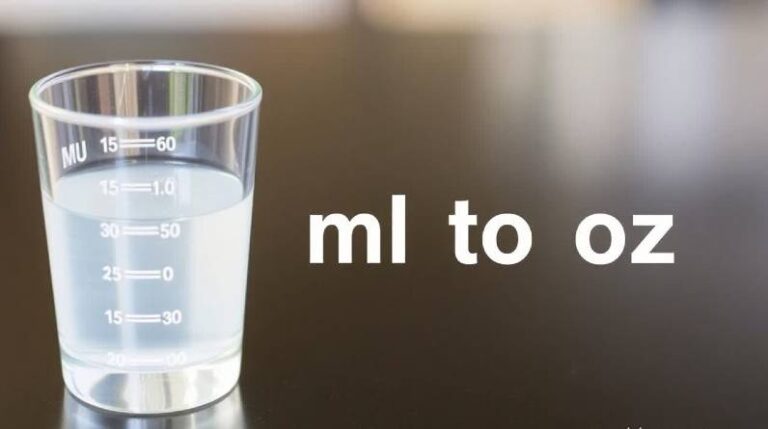When dealing with measurements in recipes, medications, or everyday liquid quantities, knowing how to convert 50 milliliters (mL) to ounces (oz) is more than a simple math exercise—it’s about understanding the context, measurement systems, and how precision impacts outcomes. This guide goes beyond the basic calculation and explores why 50 mL matters, how it translates across industries, and how you can convert and apply it with confidence.
What Is 50 mL in Ounces?
At its core, the conversion of 50 milliliters to ounces depends on which ounce system you’re using:
| Measurement System | Fluid Ounces in 50 mL |
| US Fluid Ounces | 1.6907 fl oz |
| UK (Imperial) Ounces | 1.7598 fl oz |
To convert manually:
- US fluid ounces: 50 mL ÷ 29.5735 ≈ 6907 oz
- UK fluid ounces: 50 mL ÷ 28.4131 ≈ 7598 oz
Quick Tip: If unsure which system applies, assume US fluid ounces unless you’re in the UK or using an Imperial recipe or tool.
Milliliters vs. Ounces: What’s the Difference?
Understanding the difference between mL and oz is vital to making accurate conversions.
| Unit | Type | Description |
| Milliliter (mL) | Volume | A metric unit equal to one-thousandth of a liter |
| Ounce (oz) | Volume (fluid oz) or mass (weight oz) | A US customary and imperial unit. Fluid ounces measure volume, while ounces can also mean weight |
Important Distinction: Weight vs. Volume
- Fluid ounces are used for volume (e.g., juice, water, oil).
- Ounces by weight require density information for accuracy (especially for substances like flour, honey, or syrup).
Why 50 mL Is a Common Measurement
The 50 mL mark is commonly seen in:
- Perfumes & colognes (mid-sized bottles)
- Medicine dosages
- Travel containers
- Small beverage samples
- Culinary measurements (especially in European recipes)
A Closer Look at 50 mL Across Different Substances
Different materials have different densities, which affects weight-to-volume conversions. Here’s how 50 mL converts to ounces by weight for various common substances:
| Substance | Density (g/mL) | 50 mL in oz (weight) |
| Water | 1.0 | 1.76 oz |
| Olive Oil | 0.91 | 1.60 oz |
| Milk | 1.03 | 1.81 oz |
| Honey | 1.42 | 2.50 oz |
| All-Purpose Flour | 0.59 | 1.04 oz |
Note: These are weight ounces, not fluid ounces. Always clarify the type of ounce being referred to.
Quick Reference Conversion Table (mL to oz)
Here’s a helpful table for converting small amounts of mL into ounces:
| Milliliters (mL) | US Fluid Ounces (fl oz) | UK Fluid Ounces (fl oz) |
| 10 mL | 0.338 oz | 0.351 oz |
| 20 mL | 0.676 oz | 0.704 oz |
| 30 mL | 1.014 oz | 1.056 oz |
| 40 mL | 1.352 oz | 1.408 oz |
| 50 mL | 1.691 oz | 1.760 oz |
| 60 mL | 2.029 oz | 2.112 oz |
| 100 mL | 3.381 oz | 3.520 oz |
How to Convert 50 mL to oz Accurately
Method 1: Manual Conversion
Use the formula:
Fluid ounces = Milliliters ÷ Conversion factor
- US: 50 ÷ 29.5735 ≈ 69 fl oz
- UK: 50 ÷ 28.4131 ≈ 76 fl oz
Method 2: Density-Based Conversion (for weight)
Ounces = (mL × density) ÷ 28.3495
Example:
Converting 50 mL of honey (density = 1.42 g/mL):
(50 × 1.42) ÷ 28.3495 ≈ 2.5 oz (by weight)
Method 3: Digital Converter Tools
You can also use reliable online calculators, especially when dealing with complex ingredients or high-precision tasks like baking or chemical mixing.
mL to Ounces Converter
When Precision Matters
There are specific situations where converting 50 mL to oz precisely is crucial:
1. Medical Dosages
For syrups, suspensions, and liquid medications, even minor miscalculations can have serious consequences. Always consult a pharmacist or use calibrated tools.
2. Scientific Research
Laboratory measurements in chemistry and biology rely on mL-to-oz conversions, especially when replicating experiments or mixing solutions.
3. Cooking and Baking
Precision is key in recipes—particularly in baking, where the chemical reactions depend on exact ratios of wet and dry ingredients.
Common Uses of 50 mL in Everyday Life
- Travel: TSA regulations in many countries allow up to 100 mL per container, so 50 mL is ideal for short trips.
- Nutrition & Supplements: Protein shots and vitamin drinks often come in 50 mL bottles.
- Skincare and Beauty: Creams, toners, and oils frequently come in 50 mL packaging for affordability and portability.
A Fresh Perspective: 50 mL in Eco-Conscious Packaging
With the rise of sustainable packaging, many brands now prefer 50 mL sizes to reduce waste:
- Encourages conscious consumption
- Easier to recycle smaller units
- Suitable for refillable packaging systems
In this light, the 50 mL format serves not just a functional purpose, but also supports environmental awareness and reduced material use in industries like cosmetics, pharmaceuticals, and food.
Final Thoughts
Converting 50 mL to oz seems simple at first glance, but the nuance lies in understanding the type of ounce, the context of the measurement, and the material involved. Whether you’re in a kitchen, lab, or airport, knowing how to interpret and apply this conversion equips you for accurate, informed decisions.
Frequently Asked Questions (FAQs)
Is 50 mL equal to 1 oz?
Not exactly. In US fluid ounces, 50 mL equals 1.6907 oz, and in UK fluid ounces, it’s 1.7598 oz.
How many tablespoons are in 50 mL?
There are approximately 3.38 US tablespoons in 50 mL (since 1 tbsp ≈ 14.8 mL).
Can I use 50 mL in place of 2 oz in a recipe?
It’s close but slightly less than 2 oz (1.69 oz). It may work in casual recipes, but for precision (especially in baking), it’s better to measure exactly.
Is 50 mL a common size in commercial packaging?
Yes, it’s common in cosmetics, pharmaceuticals, travel-sized products, and beverage samples.


